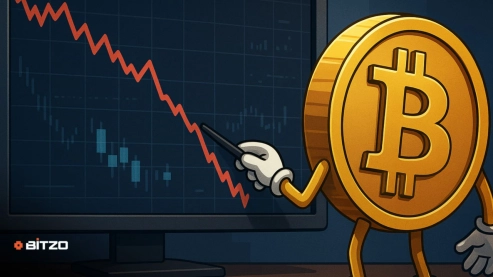Bitcoin Price Analysis: BTC Drops As Market Sours After Nvidia Crash
Bitcoin (BTC) registered a sharp decline late on Tuesday as market sentiment turned sour after the US banned the company’s H20 chip sales to China, impacting both the equity and crypto markets. As a result, the flagship cryptocurrency dropped from a high of $86,512 to settle at $83,701.
BTC is down almost 2% over the past 24 hours and trading just above $84,000 as buyers look to build momentum and attempt a move back above $85,000.
Nvidia Drags Markets Down
Nvidia shares crashed during after-hours trading after the US banned the sale of the company’s H20 chips to China. As a result, BTC tanked to $83,660, losing momentum after crossing $85,000. AI-related tokens fared worse as Nvidia disclosed that it expects to write down $5.5 billion in the first quarter thanks to the new restrictions on the exports of the H20 chip to China. The news came after unusual activity in NVDA put options suggested an impending market movement. Markets can expect a catalyst on Wednesday morning ET, with the US sales report for March expected to show a 1.2% increase in consumer spending, significantly higher than the 0.2% increase in February.
A better-than-expected report could calm fears of a trade war-induced recession. However, there is also the risk that markets may dismiss the report as backward-looking and failing to account for the escalation in trade tensions. Federal Reserve Chair Jerome Powell is also expected to speak on Wednesday and share his outlook on the US economy. Secure Digital Markets stated in a research note,
“All eyes are on Powell. Markets are holding their breath for Powell on Wednesday. Between the trade war and rising recession chatter, traders are watching for any hint the Fed might be forced to cut sooner than expected.”
Bitcoin Miners Selling More BTC
Bitcoin miners have started selling BTC to make ends meet, according to a report by CryptoQuant. According to the report, Bitcoin miners stepped up selling as the flagship cryptocurrency plunged below $80,000. It added that on April 7, miners sold 15,000 BTC worth around $1.12 billion, according to the day’s prices. Miners are generally large industrial operations that comprise specialized computers that process transactions and create new tokens. However, if the asset price takes a hit, miners are forced to sell their coins to cover costs and keep the business running.
“Miner margins have been pressured by lower prices, but also with depressed transaction fees, and a record-high Bitcoin network hash rate, which implies higher mining costs, sending their average operating margins down from 53% in late January to 33% today.”
CryptoQuant believes Bitcoin is in one of its least bullish phases since 2022, despite hitting a new all-time high ahead of President Trump’s inauguration, but has since struggled to stay above $85,000.
Why Does This Bitcoin Cycle Feel Different?
At first glance, Bitcoin appears to be in a bearish phase, registering a 21% decline from its all-time high of $109,000. However, a closer look shows that the asset is witnessing a steady rebound, with the flagship cryptocurrency up over 8% during the past week and getting closer to the psychologically important $90,000 mark. BTC climbed to an intraday high of $86,512 on Tuesday but fell below $85,000 as markets turned bearish. An analyst from CryptoQuant explained Bitcoin’s muted cycle, stating that, unlike previous cycles that featured fast-paced rallies, the current cycle is quite subdued.
According to the analyst, the lower percentage of Bitcoin held for short durations reflects minimal engagement from new market entrants. This behaviour has been attributed to two reasons, the current macroeconomic environment and the transition in market leadership from retail traders to institutional investors. The approval and growing adoption of Bitcoin ETFs have also transformed the nature of capital movement, making price movements more measured and incremental. As a result, the market is more cautious and lacks the euphoria seen in previous cycles.
Bitcoin (BTC) Price Analysis
Bitcoin (BTC) registered a notable rebound over the past week, despite facing considerable volatility and selling pressure earlier in the month. Market uncertainty generated by tariffs and Trump’s trade war had driven the price below $80,000 at the beginning of the week. However, the flagship cryptocurrency registered an admirable recovery, reclaiming $80,000 and pushing higher. BTC’s resilience is explained by several metrics, according to an analysis by CryptoQuant analyst BorisVest. According to the analyst, several on-chain indicators suggest BTC remains undervalued during the current cycle. He also pointed to declining exchange reserves, a stablecoin supply ratio suggesting available liquidity for new purchases, and a normalized funding rate indicating a reduced risk of overheated market conditions.
The analyst also flagged the ongoing reduction in exchange-held Bitcoin reserves, which have returned to levels last seen in 2018. The reduction suggests a shift towards long-term holdings, limiting immediate supply and potentially leading to a spike in prices.
Let’s look at how BTC lost momentum before rebounding towards the end of last week and which way its price could head over the next few days. BTC registered a significant decline last weekend, dropping over 6%, slipping below $80,000 and settling at $78,301. The price encountered selling pressure and volatility on Monday, falling to a low of $74,393 and then surging past $80,000 before declining to settle at $79,165, ultimately registering an increase of 1.10%. BTC lost momentum on Tuesday, dropping almost 4% and settling at $76,279. Markets rallied on Wednesday after Trump announced a pause on tariffs. As a result, BTC rallied over 8% to reclaim $80,000 and settle at $82,600. However, the rally lost momentum on Thursday as the price dropped almost 4%, slipping below $80,000 and settling at $79,592.
Source: TradingView
Sentiment changed on Friday as buyers returned to the market. As a result, BTC rose almost 5% to reclaim $80,000, move past the 20-day SMA and settle at $83,370. Buyers retained control on Saturday as the price registered an increase of over 2% to cross the 50-day SMA and settle at $85,378. Buyers lost momentum on Sunday after failing to consolidate above $85,000. As a result, BTC dropped almost 2%, slipping below the 50-day SMA and $85,000 and settling at $83,776. The current week started positively as the price rose over 1% to $84,619. It surged to an intraday high of $86,512 on Tuesday but lost momentum after reaching this level, ultimately dropping 1.08% and settling at $83,701. The current session sees BTC up almost 1% as buyers look to push the price back above $85,000.
Disclaimer: This article is provided for informational purposes only. It is not offered or intended to be used as legal, tax, investment, financial, or other advice.
Investment Disclaimer

















